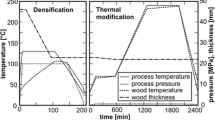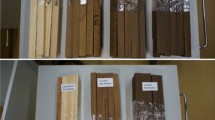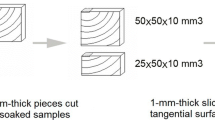Abstract
In this study, the effects of the wood quality used for thermal modification on the physical and mechanical properties obtained at two treatment temperatures commonly used at the industrial level were evaluated in order to validate experimentally the pilot scale process for its future industrial scaling. The quality of the input radiata pine refers to the presence of natural defects of wood, as well as the amount of juvenile wood. Selected thermally modified samples were used to measure some quality markers (physical, mechanical, optical) and to find their correlations due to quality or treatment, so as to obtain the best characteristics of the heat-treated products. The results indicated that the quality of the input wood was only relevant to the mild treatment (190 °C), finding an acceptable correlation between the weight loss and the quality used (first quality). After both treatments, the order of anisotropy was kept and the dimensional changes were significantly reduced; thus, the weight loss during treatment did not dramatically affect its anatomical structure. Clustering the data by statistical procedures was possible to observe that samples of lower quality were ordered according to the treatment temperature, indicating a strong influence of the treatment on the properties obtained. The mechanical properties revealed that up to 190 °C the chemical changes that occur on wood affected positively the values (MOE increased by about 15–32% and MOR slightly decreased < 5%). The thermal profile of the treated samples was comparable, suggesting that the dehydration reactions were more significant for the obtained properties than the chemical changes. Moreover, the browning effect was more stable in the samples treated at 210 °C after artificial weathering cycles, being a positive outcome that could extend the service life of the thermally modified products.





Similar content being viewed by others
References
AENOR (2006) UNE-EN 14298:2006 Sawn timber. Assessment of drying quality. Official Spanish version of European Normative EN14298:2006. Spanish Association for Standardization AENOR, Madrid, Spain
AENOR (2007) UNE-EN 14358:2007 Timber structures-Calculation of characteristic 5-percentile values and acceptance criteria for a sample. Official Spanish version of European Normative EN 14358:2007. Spanish Association for Standardization AENOR, Madrid, Spain
AENOR (2012) UNE-EN 408:2011 + A1 Timber structures—structural timber and glued laminated timber—determination of some physical and mechanical properties. Official Spanish version of European Normative EN 408:2011 + A1. Spanish Association for Standardization AENOR, Madrid, Spain
Arnold M (2010) Effect of moisture on the bending properties of thermally modified beech and spruce. J Mater Sci 45:669–680. https://doi.org/10.1007/s10853-009-3984-8
ASTM (2009) ASTM D2244-09b Standard practice for calculation of color tolerances and color differences from instrumentally measured color coordinates. ASTM International, West Conshohocken, PA, www.astm.org
ASTM (2012) ASTM G154-12 Standard practice for operating fluorescent ultraviolet (UV) Lamp apparatus for exposure of nonmetallic materials. ASTM International, West Conshohocken, PA, www.astm.org
Ayadi N, Lejeune F, Charrier F, Charrier B, Merlin A (2003) Color stability of heat-treated wood during artificial weathering. Eur J Wood Prod 61:221–226. https://doi.org/10.1007/s00107-003-0389-2
Barcík Š, Gašparík M, Razumov E (2015) Effect of temperature on the color changes of wood during thermal modification. Cellul Chem Technol 49:789–798
Belgacem MN, Pizzi A (2016) lignocellulosic fibers and wood handbook: renewable materials for today’s environment. Wiley, Hoboken
Boonstra M (2008) A two-stage thermal modification of wood. Doctoral dissertation, Université Henri Poincaré-Nancy 1, France. Avalaible online: https://hal.univ-lorraine.fr/tel-01748345/document
Boonstra M (2016) Dimensional stabilization of wood and wood composites. Lignocellulosic fibers and wood handbook. Wiley, Hoboken, pp 629–655
Boonstra M, Van Acker J, Tjeerdsma B (2007a) Strength properties of thermally modified softwoods and its relation to polymeric structural wood constituents. Ann For Sci 64:679–690
Boonstra MJ, Van Acker J, Tjeerdsma BF, Kegel EV (2007b) Strength properties of thermally modified softwoods and its relation to polymeric structural wood constituents. Ann For Sci 64:679–690. https://doi.org/10.1051/forest:2007048
Brischke C, Welzbacher CR, Brandt K, Rapp AO (2007) Quality control of thermally modified timber: interrelationship between heat treatment intensities and CIE L*a*b* color data on homogenized wood samples. Holzforschung 61:19–22. https://doi.org/10.1515/HF.2007.004
Brito JO, Silva FG, Leão MM, Almeida G (2008) Chemical composition changes in eucalyptus and pinus woods submitted to heat treatment. Bioresour Technol 99:8545–8548. https://doi.org/10.1016/j.biortech.2008.03.069
Bulian F, Graystone J (2009) Wood coatings theory and practice. Elsevier Science, Amsterdam. https://doi.org/10.1016/b978-0-444-52840-7.x0001-x
Candelier K, Hannouz S, Elaieb M et al (2015) Utilization of temperature kinetics as a method to predict treatment intensity and corresponding treated wood quality: Durability and mechanical properties of thermally modified wood. Maderas Cienc y Tecnol. https://doi.org/10.4067/s0718-221x2015005000024
Candelier K, Thevenon MF, Petrissans A et al (2016) Control of wood thermal treatment and its effects on decay resistance: a review. Ann For Sci 73:571–583
Cerc Korošec R, Lavrič B, Rep G et al (2009) Thermogravimetry as a possible tool for determining modification degree of thermally treated Norway spruce wood. J Therm Anal Calorim 98:189–195. https://doi.org/10.1007/s10973-009-0374-z
Chittenden C, Singh T (2011) Antifungal activity of essential oils against wood degrading fungi and their applications as wood preservatives. Int Wood Prod J 2:44–48. https://doi.org/10.1179/2042645311Y.0000000004
Esteves B, Carmo J, Nunes L (2014) Commercialisation and production of modified wood in Portugal. In: Nunes Lina (ed) European Conference on Wood Modification 2014. Lisbon
González-Peña MM, Curling SF, Hale MDC (2009) On the effect of heat on the chemical composition and dimensions of thermally-modified wood. Polym Degrad Stab 94:2184–2193. https://doi.org/10.1016/J.POLYMDEGRADSTAB.2009.09.003
Grønli MG, Varhegyi G, Di Blasi C (2002) Thermogravimetric analysis and devolatilization kinetics of wood. Ind Eng Chem Res 41:4201–4208. https://doi.org/10.1021/ie0201157C
Hakkou M, Pétrissans M, Zoulalian A, Gérardin P (2005) Investigation of wood wettability changes during heat treatment on the basis of chemical analysis. Polym Degrad Stab 89:1–5. https://doi.org/10.1016/j.polymdegradstab.2004.10.017
Hermoso E, Fernández-Golfín J, Conde M et al (2015) Caracterización de la madera aserrada de Pinus radiata modificada térmicamente (Characterization of thermally modified Pinus radiata timber). Maderas Cienc y Tecnol 17:5. https://doi.org/10.4067/s0718-221x2015005000044
Herrera R, Muszyńska M, Krystofiak T, Labidi J (2015) Comparative evaluation of different thermally modified wood samples finishing with UV-curable and waterborne coatings. Appl Surf Sci 357:1444–1453. https://doi.org/10.1016/j.apsusc.2015.09.259
Herrera R, Arrese A, de Hoyos-Martinez P, Labidi J (2018) Evolution of thermally modified wood properties exposed to natural and artificial weathering and its potential as an element for façades systems. Constr Build Mater 172:233–242
Herrera-Díaz R, Sepúlveda-Villarroel V, Pérez-Peña N et al (2017) Effect of wood drying and heat modification on some physical and mechanical properties of radiata pine. Dry Technol. https://doi.org/10.1080/07373937.2017.1342094
Hon DN-S, Shiraishi N (2001) Color and discoloration. Wood and cellulosic chemistry. Marcel Dekker, South Carolina, pp 385–442
INN (1988) Norma Chilena Oficial NCh 176/2 Madera—Parte 2: Determinación de la densidad. (Official Chilean Standard NCh 176/2 Wood—Part 2: Determination of density). National Institute of Normalization, INN, Santiago, Chile
Kamdem DP, Pizzi A, Jermannaud A (2002) Durability of heat-treated wood. Holz Roh Werkst 60:1–6. https://doi.org/10.1007/s00107-001-0261-1
Kocaefe D, Younsi R, Poncsak S, Kocaefe Y (2007) Comparison of different models for the high-temperature heat-treatment of wood. Int J Therm Sci 46:707–716. https://doi.org/10.1016/J.IJTHERMALSCI.2006.09.001
Kocaefe D, Poncsak S, Boluk Y (2008) Effect of thermal treatment on the chemical composition and mechanical properties of birch and aspen. BioResources 3:517–537
Kocaefe D, Huang X, Kocaefe Y, Boluk Y (2013) Quantitative characterization of chemical degradation of heat-treated wood surfaces during artificial weathering using XPS. Surf Interface Anal 45:639–649. https://doi.org/10.1002/sia.5104
Korkut DS, Guller B (2008) The effects of heat treatment on physical properties and surface roughness of red-bud maple (Acer trautvetteri Medw.) wood. Bioresour Technol 99:2846–2851. https://doi.org/10.1016/j.biortech.2007.06.043
Kránitz K, Sonderegger W, Bues C-T, Niemz P (2016) Effects of aging on wood: a literature review. Wood Sci Technol 50:7–22. https://doi.org/10.1007/s00226-015-0766-0
Laurichesse S, Avérous L (2014) Chemical modification of lignins: towards biobased polymers. Prog Polym Sci 39:1266–1290. https://doi.org/10.1016/J.PROGPOLYMSCI.2013.11.004
Metsä-Kortelainen S, Viitanen H (2012) Wettability of sapwood and heartwood of thermally modified Norway spruce and Scots pine. Eur J Wood Prod 70:135–139. https://doi.org/10.1007/s00107-011-0523-5
Militz H (2008) Processes and properties of thermally modified wood manufactured in Europe. In: ACS Symposium Series. pp 372–388
Militz H, Altgen M (2014) Processes and properties of thermally modified wood manufactured in Europe. In: Schultz TP, Goodell B, Nicholas DD (eds) Deterioration and protection of sustainable biomaterials. ACS Symposium Series, pp 269–285
Niemz P, Hofmann T (2010) Thermally modified wood. Maderas Cienc y Tecnol 12:69–78. https://doi.org/10.4067/SO718-221X2010000200002
Ormondroyd G, Spear M, Curling S (2015) Modified wood: review of efficacy and service life testing. Proc Inst Civ Eng 5:6. https://doi.org/10.1680/coma.14.00072
Pang S (2002) Predicting anisotropic shringkage of softwood part 1: theories. Wood Sci Technol 36:75–91. https://doi.org/10.1007/s00226-001-0122-4
Prins MJ, Ptasinski KJ, Janssen FJJG (2006) Torrefaction of wood. Part 2. Analysis of products. J Anal Appl Pyrolysis 77:35–40. https://doi.org/10.1016/j.jaap.2006.01.001
Rautkari L, Honkanen J, Hill CAS, Ridley-Ellis D, Hughes M (2014) Mechanical and physical properties of thermally modified Scots pine wood in high pressure reactor under saturated steam at 120, 150 and 180 °C. Eur J Wood Prod 72:33–41. https://doi.org/10.1007/s00107-013-0749-5
Rezayati Charani P, Mohammadi Rovshandeh J, Mohebby B, Ramezani O (2007) Influence of hydrothermal treatment on the dimensional stability of beech wood. Casp J Environ Sci 05:125–131
Salinas C, Chavez C, Ananias RA, Elustondo D (2015) Unidimensional simulation of drying stress in radiata pine wood. Dry Technol 33:996–1005. https://doi.org/10.1080/07373937.2015.1012767
Sandberg D, Kutnar A (2016) Thermal modified timber (tmt): recent development in Europe and North America. Wood Fiber Sci 48:28–39
Shi JL, Kocaefe D, Zhang J (2007) Mechanical behaviour of Québec wood species heat-treated using Thermo Wood process. Holz Roh Werkst 65(4):255–259. https://doi.org/10.1007/s00107-007-0173-9
Tiryaki S, Hamzaçebi C (2014) Predicting modulus of rupture (MOR) and modulus of elasticity (MOE) of heat treated woods by artificial neural networks. Measurement 49:266–274. https://doi.org/10.1016/J.MEASUREMENT.2013.12.004
Willems W (2009) A novel economic large-scale production technology for high-quality thermally modified wood. European conference on wood modification. SP Technical Research Institute of Sweden, Stockholm, pp 31–35
Willems W, Lykidis C, Altgen M, Clauder L (2015) Quality control methods for thermally modified wood: COST action FP0904 2010–2014: thermo-hydro-mechanical wood behaviour and processing. Holzforschung 69:875–884. https://doi.org/10.1515/hf-2014-0185
Xing D, Li J (2014) Effects of heat treatment on thermal decomposition and combustion performance of Larix spp. wood. BioResources 9:4274–4287. https://doi.org/10.15376/biores.9.3.4274-4287
Yildiz S, Gümüşkaya E (2007) The effects of thermal modification on crystalline structure of cellulose in soft and hardwood. Build Environ 42:62–67. https://doi.org/10.1016/j.buildenv.2005.07.009
Yildiz S, Tomak ED, Yildiz UC, Ustaomer D (2013) Effect of artificial weathering on the properties of heat treated wood. Polym Degrad Stab 98:1419–1427. https://doi.org/10.1016/j.polymdegradstab.2013.05.004
Younsi R, Kocaefe D, Poncsak S, Kocaefe Y (2010) Computational and experimental analysis of high temperature thermal treatment of wood based on thermo wood technology. Int Commun Heat Mass Transf 37:21–28
Acknowledgements
The authors appreciate the financial support of the National Commission of Scientific & Technological Research (Conicyt) of Chile (Fondequip EQM130812). The first author would like to thank the Basque Government, Postdoctoral program (POS-2018-1-0077) for financially supporting a part of this research.
Author information
Authors and Affiliations
Corresponding author
Additional information
Publisher’s Note
Springer Nature remains neutral with regard to jurisdictional claims in published maps and institutional affiliations.
Rights and permissions
About this article
Cite this article
Herrera-Díaz, R., Sepúlveda-Villarroel, V., Torres-Mella, J. et al. Influence of the wood quality and treatment temperature on the physical and mechanical properties of thermally modified radiata pine. Eur. J. Wood Prod. 77, 661–671 (2019). https://doi.org/10.1007/s00107-019-01424-9
Received:
Published:
Issue Date:
DOI: https://doi.org/10.1007/s00107-019-01424-9




